How to Train a Mini Goldendoodle: 10 Expert Tips & Advice
By Kit Copson
Updated on

Bringing home a dog is a very exciting time. It’s also a crucial period for your new puppy or adult dog in terms of training and socialization, and it’s best to get down to business straight away! That’s easy enough to say, but if you’re a first-time dog parent, deciding where to start can be overwhelming.
We’ve been there and know how tough it can be, so we’ve put together this collection of training tips to help you get started molding your Mini Goldendoodle into a model citizen! At the end, we’ll give you a brief tutorial on teaching some of the most basic commands.
The 10 Tips to Train a Mini Goldendoodle
1. Figure Out What Motivates Your Dog
Does your mini Goldendoodle positively melt when you praise them? Or perhaps they can’t get enough of a certain kind of treat. Whatever the case may be, take note, as you can use this as a way of motivating your dog and positively reinforcing the behaviors you want to see.
When your mini Goldendoodle does something you want them to do, immediately praise or reward the behavior with whatever motivation tool works best for them. This encourages them to repeat the behavior.
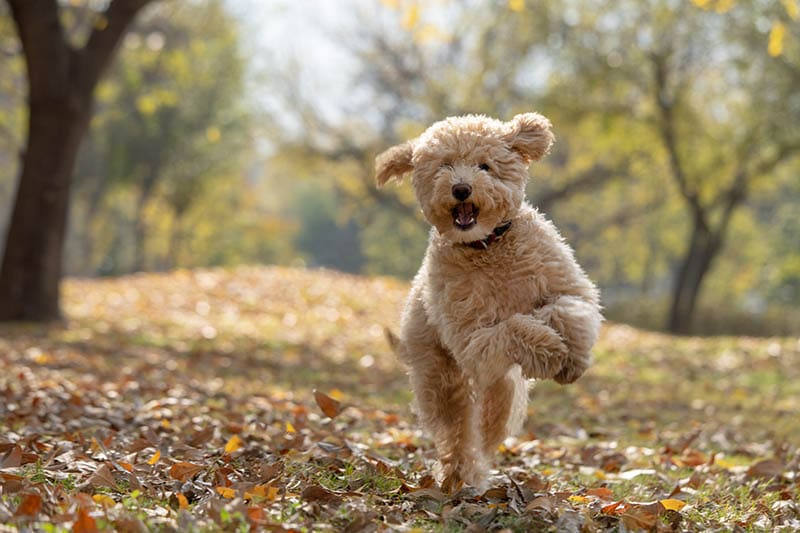
2. Pick a Distraction-Free Zone
In the beginning, you’ll want to pick training areas that are calm, quiet, and distraction-free. If a dog has never had any kind of training, it’s normal for them to be distracted by other dogs, people, cars, bikes, and pretty much any object they find remotely interesting, which can be detrimental. Start training sessions at home to help your dog pick up the basics more quickly.
3. Start with the Basics
Pick some basic but crucial commands to focus on at the beginning, like “sit”, “come”, “down”, and “stay” (we’ll share some tips on how to teach basic commands further down).
These are fundamental because they help keep you in control of social situations and keep your dog safe. They’re also really easy to teach as long as you’re consistent and patient and motivate your dog with whatever it is they like most.
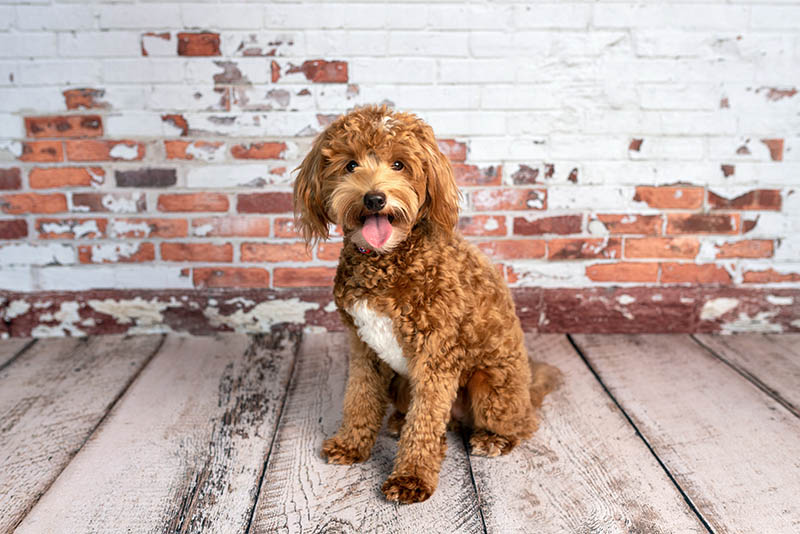
4. Use and Understand Body Language
Be mindful of how you’re holding yourself when training your mini Goldendoodle, as this is something dogs understand very well. Dogs learn best when the person training them is unflappable, so adopt a relaxed stance in training sessions.
Avoid looking too relaxed, though—slouching can make you appear unconfident, and your dog will pick up on this and assume that they are the pack leader, not you. It can also make them feel insecure, so aim to be relaxed and self-assured around your dog. Moreover, dogs can read body language like frowns and smiles.
It’s also a good idea to read up on dog body language to better understand what your mini Goldendoodle is trying to tell you. For example, yawning can indicate stress in dogs, as can lip-licking. On the other hand, a tail held high indicates alertness, confidence, or, in some cases, aggression. There are various ways in which dogs express their feelings through body language.
5. Use Different Tones of Voice
When it comes to communicating verbally, dogs understand tone, not the word you’re using. For example, if you’re praising your dog, a cheerful, high-pitched voice tells them that you’re happy with what they’re doing. By contrast, if your voice is low-pitched, quiet, and firm, you’re telling your dog that you aren’t happy with their behavior.
For emergencies, a word that’s spoken at any pitch but loudly lets the dog know that they need to be careful. “Stop!” is a good example. Just be careful not to use the caution command frequently, as the dog needs to understand that it’s only used in emergencies.

6. Break Training into Short Sessions
Make training sessions too long winded, and the result will be a bored dog that doesn’t retain much. 10–15 minutes is just enough, though you can do these short sessions multiple times per day. Finish each session on a positive note, for example, by working on a command your dog knows well.
7. Use the Word “Good” with the Command
When your Mini Goldendoodle does what you ask them to do, say “good” followed by the command you used to get them to do what they did, for example, “good sit”, then reward your dog with a treat or whatever you use to motivate them. This is a method of marking good behavior when it happens.
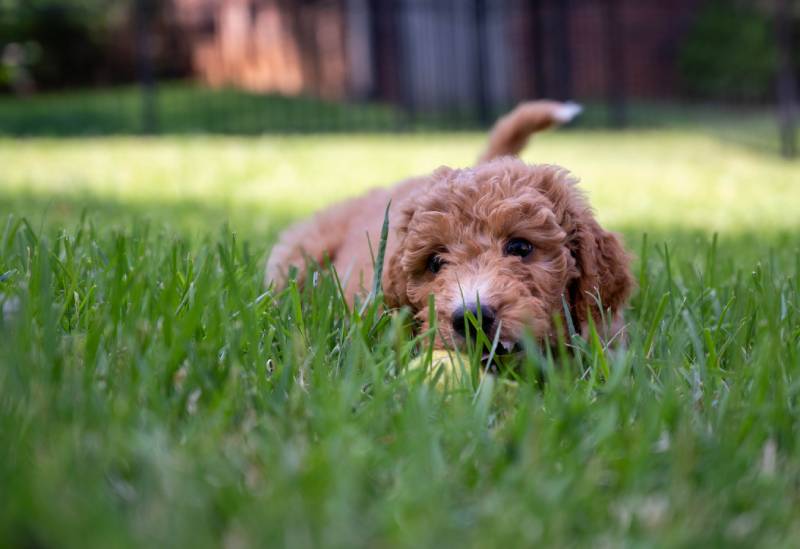
8. Train Your Dog to Walk Properly on a Leash
When you’re out and about with your mini Goldendoodle, they should not be walking ahead of you and/or pulling you here, there, and everywhere. It’s best to teach them how to walk on a loose leash, which means they’ll be walking at your side without you having to exert any effort.
You can start by teaching your mini Goldendoodle a command like “with me” or “heel”. When they pull ahead, give the command and encourage them to come to your side. Hold a treat in front of your chest, making sure your dog sees it, and use it to guide your dog, keeping them by your side the whole time before rewarding them.
At first, reward your dog simply for coming to your side, then move on to rewarding them for walking at your side for a few steps and gradually increasing the time they need to stay by your side to get the reward. Say “good” or “yes” to mark the behavior before you reward. You can also practice this at home.
9. Don’t Be Harsh
If your dog does something you don’t like, it can be frustrating, but you should avoid physical punishment or yelling. Instead of getting the dog to behave in the way you want, it will only make them anxious around you and have an overall negative impact. Remain calm and continue working with your dog on problem areas, using positive reinforcement to encourage them.
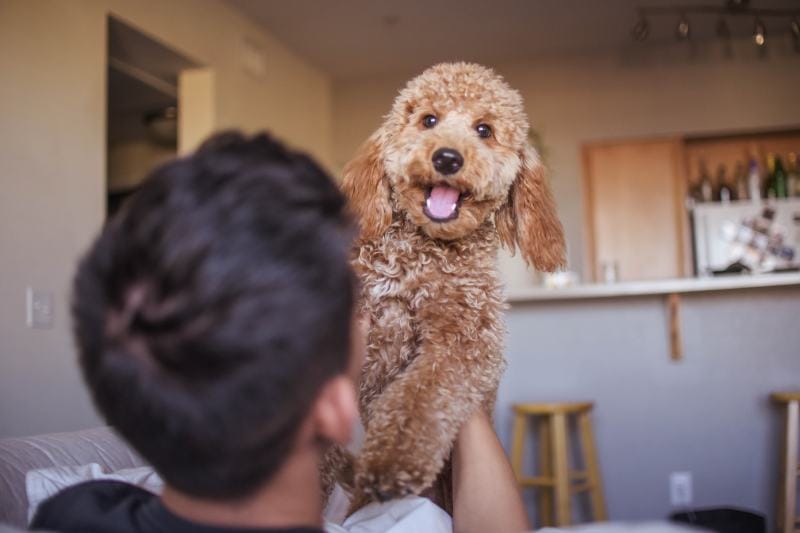
10. Be Kind and Consistent
Dogs learn at different speeds, so don’t expect too much too soon, and don’t be disheartened if it takes a while to train your mini Goldendoodle. It’s important to remember that they’re not behaving a certain way out of spite, but only because they haven’t quite got the hang of things yet.
If you are positive, kind, and consistent, your bond with your dog will strengthen and they will respond much better than if you were irritable or approaching training with a negative attitude.
How to Teach Basic Commands
It’s easy for us to advise you to teach basic commands, but that doesn’t explain how to actually do it. To give you a head-start, here’s how to teach your dog three core commands—“sit”, “stay”, “down”, and “come”.
“Sit”
Stand in front of your dog with a treat in your hand, positioned so they can see it, and give the “sit” command. Move the treat in an arc-like motion above the dog’s head, and your dog should follow it with his eyes and naturally go into the sitting position. Say “Good sit” and give the treat immediately when the dog sits.
“Come”
Standing a little away from your dog (you can gradually increase the distance with time), say your dog’s name and then “come” in a happy tone. Crouching down a bit may also encourage them to come to you. When your dog comes, say “Good come” and reward them with a treat. It may take a little time to get it, so don’t worry if your dog doesn’t react to the command straight away.
As with other commands, it’s a good idea to start doing this in your home or yard before you start practicing more in public areas, like secure dog parks.
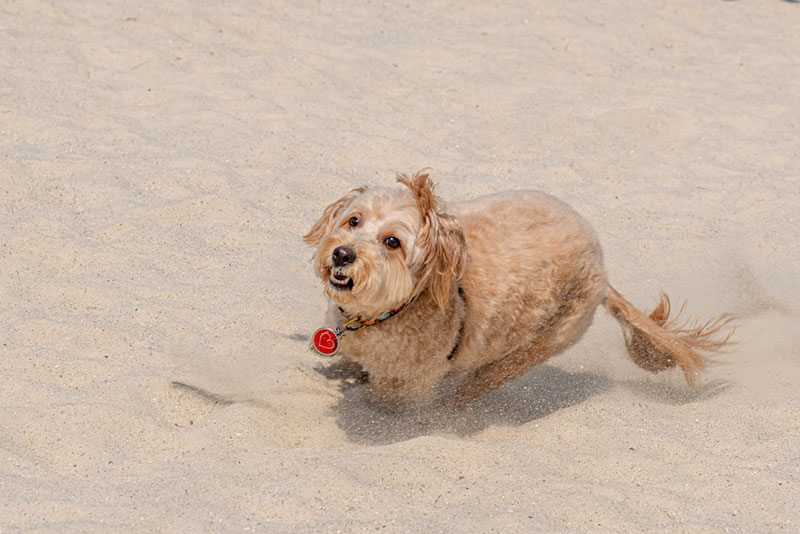
“Down”
Hold a treat in front of your dog’s nose (not close enough so they can grab it, though) while they’re sitting down, and give your verbal cue (“down”) while moving the treat downwards towards the ground to encourage your dog down to follow it and lie down on their belly. Reward them straight away.
“Stay”
Give your dog the “down” cue, then hold your hand up as if to say “stop”. Give the “Stay” command and wait a few seconds before giving the treat to your dog. Gradually increase the length of time they have to wait before they get the treat over several practice sessions.
Conclusion
Goldendoodles are well-known for being responsive to training and easy to please, so with consistency, patience, and a positive attitude, you’re sure to see results in the training department very soon. Nevertheless, if you’re experiencing a few too many bumps in the road, consider working with a professional trainer. Also, it’s always a good idea to attend training and socialization classes.
Featured Image Credit: Tanya Consaul Photography, Shutterstock













